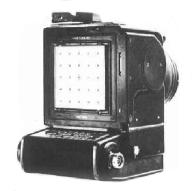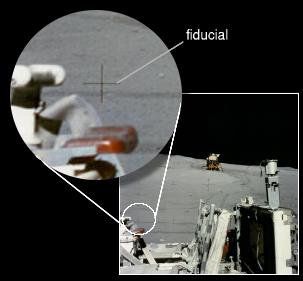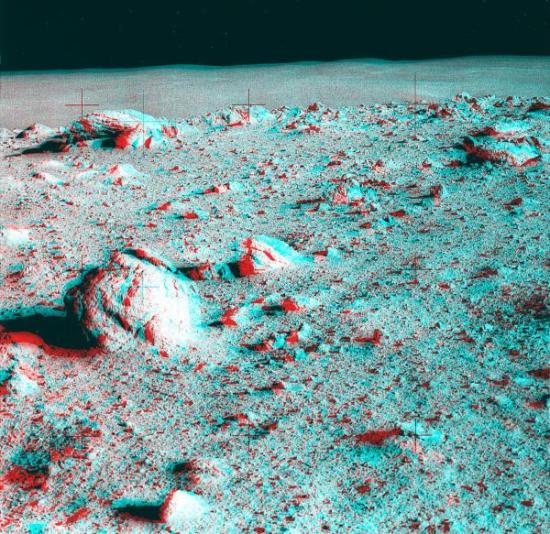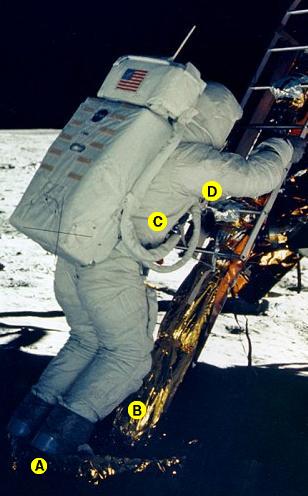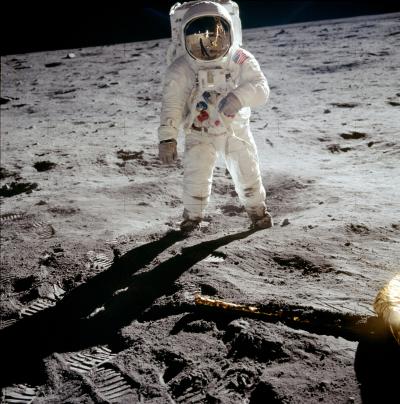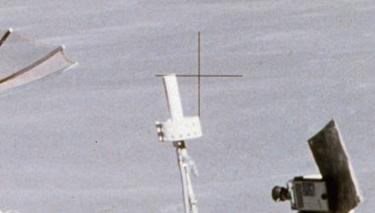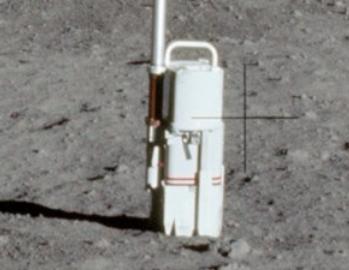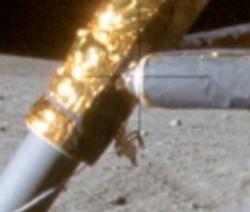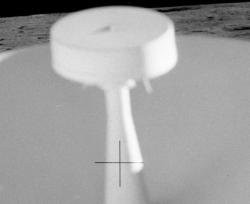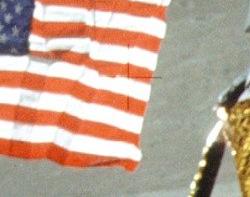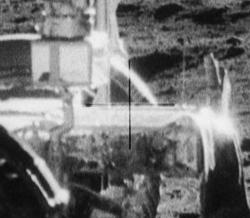crosshairs







The lunar surface Hasselblad cameras were fitted with a device called
a reseau plate. The reseau plate is a clear glass plate on which is
etched small black crosshairs, called "fiducials" by some and
"reticles" by others. As each film frame is drawn into place, it is
pressed against the reseau plate so that the picture is taken through
the plate. This results in an image of the fiducials being
superimposed over the image focused through the lens.
|
|
A reseau grid is used in the science of photogrammetry to establish a geometrical basis for measuring objects in photographs. It can be used to correct for any misalignment of the film in the camera, or distortions in the image after development or electronic scanning. Since the location of the marks on the reseau plate is known with great precision, correcting for distortion is a simple matter of manipulating the image until the marks are in the correct location.
If you take several photographs of an object from different angles, and locate the features of that object in relation to the fiducials, and you know something about the design of the camera, you can actually reconstruct the three-dimensional geometry of the object. This is what photogrammetry tries to do. Mapmakers use photogrammetry to render aerial photographs into maps. Architects use photogrammetry to measure the features of existing buildings quickly and easily.
Fig. 1 (left) shows a standard Hasselblad 500/EL Data Camera with the film magazine removed to display the reseau plate. There is a large fiducial in the center, and two rows of fiducials above and below, left and right of the center.
 NASA claims they're for
measuring distances.
NASA claims they're for
measuring distances.
NASA spokesman Brian Welch has been quoted as saying you could measure things in the photos by using the fiducials and knowing something about how the photo was taken. This is a clear reference to the science of photogrammetry, for which the reseau plate was provided. However, since the astronauts didn't take multiple photos of everything, especially in early missions, it's not possible to perform photogrammetric analysis on every Apollo photograph.
NASA photo analysts frequently locate details in photos using the fiducials as a reference grid. In recent times this has become the primary function of the reseau grid.
 Hasselblad
representatives claim the crosshairs couldn't be used for measuring
distances. [Mary Bennett and David Percy]
Hasselblad
representatives claim the crosshairs couldn't be used for measuring
distances. [Mary Bennett and David Percy]
Mr. Jan Lundberg was the Hasselblad engineer responsible for modifying the company's 500/EL Data Camera for use on the moon. He is not, however, an expert on all things photographic. The authors have employed a common tactic of consulting one and only one expert and taking all his responses as gospel, even if the questions aren't necessarily within his expertise.
In the authors' book Dark Moon, Lundberg described the use of fiducials:
"They used them to correct for distortion of the lens and they can measure the distance between the crosses and determine of the film has 'curved' because if so, these crosses will be slightly dislocated. They did not help [NASA] in judging lunar distances." (op. cit., p. 68. Emphasis and brackets in original.)
Mr. Lundberg is correct in identifying the primary purpose of the reseau grid as a means to detect and correct film distortion. But he is incorrect in claiming that the reseau grid can correct for lens distortion. Because the reseau plate is pressed up against the film, the reseau grid on the film is entirely independent of the lens. You can even remove the lens and a reseau grid will still be exposed properly on the film.
In the authors' companion video What Happened on the Moon? David Percy asked Mr. Lundberg if the fiducials could be used for measuring photographed objects. Lundberg replies that multiple camera angles (e.g., stereo pairs) would be required. This is a somewhat different story. When interviewed for the book, Lundberg said the fiducials were no help in measuring objects. But when interviewed for the film, he hedges a bit and says that such a thing would be possible if they took stereo pairs.
As a matter of fact, reseau grids are commonly used as measurement references in photogrammetry, contrary to Mr. Lundberg's claim in the book. We provide a few references at the bottom of the page to help substantiate this. Mr. Lundberg does not appear really to be an authority on reseau grids.
Both Welch and Lundberg refer in roundabout ways to photogrammetry, but the reader/viewer isn't likely to make that connection. Welch and Lundberg both qualify their answers, and Percy doesn't follow up on the details of those stipulations. Welch doesn't give a complete treatise on photogrammetry (he's a public relations man, not a scientist), and Lundberg apparently isn't aware that the astronauts took many stereo pairs with the Hasselblad cameras.
This is the point where a conscientious author tries to fill in the apparent gaps between the experts, but instead Bennett and Percy try to widen that gap as much as possible. Their aim is to convince the reader that NASA spokesmen and industry experts fully disagree on the purpose of the reseau grid, even though each gave a partially defensible answer.
We'll close this section with a stereogram made from a stereo pair taken by Apollo 14 astronauts on the rim of Cone Crater. This is an example of literally hundreds of stereo pairs taken by the astronauts to provide a three-dimensional basis. Use a red filter on the left eye and a blue filter on the right eye.
|
|
 In some photographs the
large crosshair is not centered, and in others the grid is not aligned
with the image boundaries. [Bennett and Percy, Dark Moon,
p. 68]
In some photographs the
large crosshair is not centered, and in others the grid is not aligned
with the image boundaries. [Bennett and Percy, Dark Moon,
p. 68]
The conspiracists are correct in pointing out that since the reseau plate is an integral part of the camera and doesn't move, the reseau grid should appear perfectly aligned in every photograph.
The Hasselblad cameras took square pictures. For various reasons many of the copies of Apollo photographs, digital or film, are cropped for convenience or for presentation. Many (Fig. 3) are also rotated to correct for tilted cameras.
Cropped Apollo photos are extensively available on the Internet, including many here on Clavius, and even from some NASA sites. Very few Apollo photos are presented in their original composition. A cropped photo isn't expected to keep the large fiducial centered.
But Bennett and Percy maintain that the "classic" shot of Buzz Aldrin (AS11-40-5903, which we discuss here in detail) has a misaligned fiducial on the original transparency. Photo 20, page 68 of Dark Moon attempts to show that the distance from the top and bottom borders to the center fiducial is not equal, as it should be.
The authors' reproduction of the photo claims to be the "full area" of the photograph. Indeed we verify that the image in Dark Moon is indeed square (69 millimeters on each side). But a curious feature catches our eye. The authors have added a little "headroom" above Aldrin. Photo analysts have known for years that a sliver of the top edge of Aldrin's PLSS backpack is actually cut off by the top of the frame. But Bennett and Percy place the top of the frame 4 mm above the PLSS.
How were they able to to that? The original transparency roll puts a 2 cm margin between the top of one frame and the bottom of the adjacent frame. The transparency is normally dark, so it becomes very difficult to distinguish between the blackness of the margin and the blackness of the lunar sky. The authors here have invaded the margin to provide Aldrin some headroom.
But in order to keep the photo square, they would have to cut off 4 mm from the bottom. And indeed Fig. 4, which was scanned from the original transparency (not a duplication or print), shows that there is more to the bottom of the photo than Bennett and Percy provide in their book.
|
Sure enough, if we find the geometrical center of the photo in Dark Moon, it is exactly 4 mm above the fiducial as they have emphasized it. The fiducial is off by exactly the amount the authors have shifted the photograph's borders in order to create their "anomaly".
 The crosshairs are
partially covered in some photographs. This suggests that the
photographs were composed by cutting and pasting objects over the
background images, obscuring the crosshairs in the
process.
The crosshairs are
partially covered in some photographs. This suggests that the
photographs were composed by cutting and pasting objects over the
background images, obscuring the crosshairs in the
process.
|
Since the reseau grid is created by a glass plate pressed up against the film, it is impossible for any photographed object to appear "in front" of the grid in the photo. Conspiracists give examples like Fig. 5 to illustrate their point. The natural layman's conclusion is that the object has been "pasted over" the fiducial.
|
Mary Bennett and David Percy reproduce a photo of the close-up surface camera on page 67 of Dark Moon, and in their video. In their version, the fiducial seems to go right up to the edge of the white camera and then completely disappear. That would certainly suggest that a separate picture of the camera had been pasted over the background, which contained the fiducial.
But a closer examination of the photograph reveals what's really going on. Figure 6 is a scan from the original transparency of the photo shown in Dark Moon. Here it's obvious that the camera doesn't cover the fiducial; it just makes it fainter and harder to see. Very often the JPEGs and other poor-quality versions of the photos that appear on the Internet do not faithfully reproduce such fine details. So it's easy to see why people using those sources would believe that the fiducials simply disappear.
But this raises a question. In correspondence, David Percy claimed they used 70mm duplicate transparencies for their analysis. Yet Percy's "anomalies" seem to be those that appear only in low-quality copies. Just how diligent has Percy been in ascertaining that his "anomalies" are not simply the inevitable flaws that arise from duplication and mass dissemination?
Further, we find that the conspiracists have presented the evidence very selectively. The phenomenon of missing or washed-out fiducials is actually very common, and most often occurs in ways that suggest the fiducials are not obscured by entire objects pasted over them.
|
The conspiracists don't show you these photos and the many hundreds like them because then they'd have to explain why someone would need to cut and paste just the white stripes on the flag, or just the fitting at the end of a strut. That makes the cut-and-paste argument seem absurd -- which it is, when seen in the light of all the evidence.
Bennett and Percy (op. cit., p. 68) admit that "these partially hidden reticles [i.e., fiducials] may be the result of over exposure." But they don't pursue that hypothesis any further, and surely don't admit as such in their video What Happened on the Moon?. And on page 67 of the book they show the photo from Fig. 5 and identify the washed-out fiducial with the label "Whistle-Blowing". Which is it: an natural photographic phenomenon, or a whistle-blow? In fact, the authors attribute this claim to Ralph Rene, who is not a photographer. So even though David Percy, who is a photographer, correctly identifies the source of the washout, that doesn't prevent him from spreading a little misinformation in order to help out his whistle-blower theory.
The photographers we consulted agreed that the fiducial washout was almost certainly the result of bright areas of the emulsion "bleeding" over the tiny fiducials. The fiducials are very thin, only about 0.004 inch thick (0.1 mm). The emulsion would only have to bleed about half that much -- less than the thickness of a human hair -- in order to completely obscure the fiducial.
Several photographers have tested this phenomenon using hairs, wires, and other thin objects stretched over the film plane. With the assistance of Zig Zag Productions in London, we obtained a modern 70mm Hasselblad data camera fitted with a reseau plate (which is a standard accessory, not something made especially for Apollo). When we shot a roll of Ektachrome 160 film against brightly lit objects such as replicas of Apollo space suits, we found that the fiducials indeed were made fainter, and in some cases were completely obliterated, by the act of exposure alone.
There is simply no reason to look to farfetched explanations such
as cutting and pasting or elaborate whistle-blowing to account for an
observation that can be easily reproduced using the camera alone in
unremarkable ways. The conspiracists have carefully guided the reader
to the predetermined conclusion, irrespective of the evidence.
HOW NOT TO
FAKE PHOTOGRAPHS
 The misaligned fiducials
prove that some clear plastic sheet containing the grid was placed
over the final composite photo, and that this sheet was sometimes
aligned wrong for the final shot. The missing fiducials prove that a
photo compositing process was used to create the photos.
The misaligned fiducials
prove that some clear plastic sheet containing the grid was placed
over the final composite photo, and that this sheet was sometimes
aligned wrong for the final shot. The missing fiducials prove that a
photo compositing process was used to create the photos.
This is a good example of nonsensical ad hoc conspiracy arguments. They concentrate on how their proposal would produce the observed characteristics without considering whether it makes sense, is self-consistent, or indeed is a good way of faking something.
First, we note that the two observations -- misaligned fiducials and missing fiducials -- have mutually contradictory explanations. Each one postulates a very different process of falsification. In the misaligned fiducial case, the marks are added as the final step by putting a large plastic sheet containing the marks over the top of the complete composite image. But in the missing fiducial case, the marks are already there on the background plate, and new foreground objects are pasted into the scene.
Let's say the fiducials were already in the background. If a photo compositor is pasting in, say, a picture of the ALSCC camera, why wouldn't he simply take a technical pen and redraw the fiducial? And if he left it out intentionally, why didn't an inspector catch it and make him fix it? And as we already noted, why would someone need to paste in only the white stripes of the flag?
The smart way to fake a photo incorporating a reseau grid would be to compose the photo on the light table without the grid and then to apply it as a final step once everything else was complete, as is suggested in the plastic sheet hoax theory. Applying it first to the background would not save time or be any easier, but it would cause lots of problems if you then wanted to doctor the photo. But you don't need to bother with a plastic sheet. Just fit a standard reseau plate to the final process camera. Then each composited photo would have a perfect reseau grid with no special effort on the part of the compositor.
The conspiracists have proposed methods by which NASA faked the
photos. But when we look at these methods, we find that they are
unnecessarily awkward and prone to error -- in other words, they don't
make sense. We can immediately see much better ways of faking these
particular photos, if we chose to do it. This leads us to the
conclusion that the proposed scenarios have only the criteria (a) they
fit the observations, and (b) they espouse some hoax theory. At no
point does it seem they considered, (c) this is a plausible way of
doing it. In short, they are nonsense explanations that simply serve
the predetermined conclusion.
NOTES
